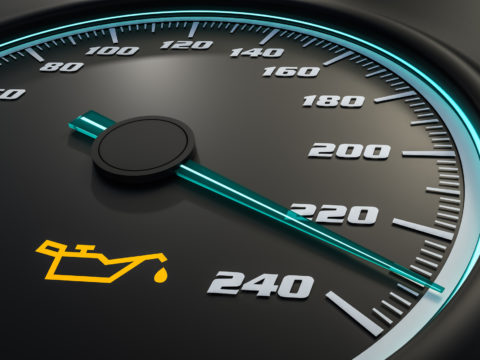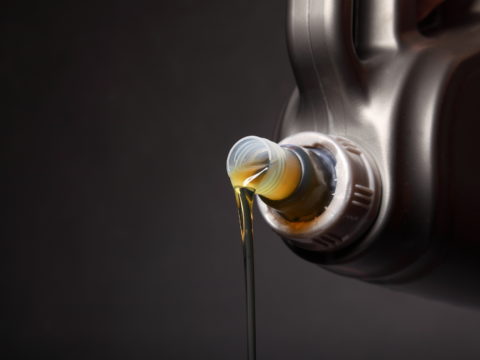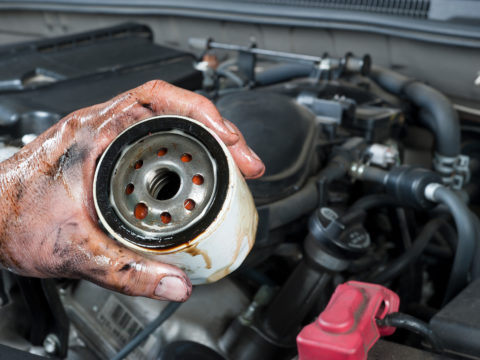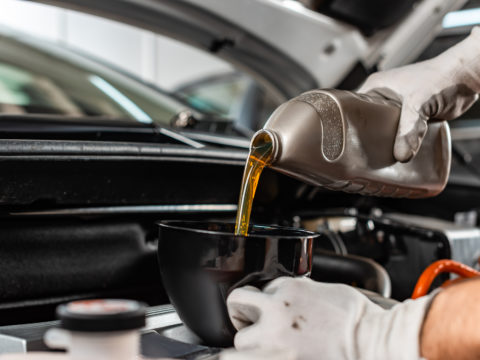Every vehicle needs oil to function, and the oil pan is what allows oil to flow to the engine to keep proper temperature levels and lubrication. A pump moves oil from the pan to a filter, and from there, the oil goes to the engine. Generally, oil pans are made from steel for durability, though this can differ from vehicle to vehicle.
An oil pan leak means that your car is leaking various amounts of oil, which it should not be doing under normal circumstances. There are a few different symptoms and causes that people commonly associate with oil pans, so we’ll go over those in more detail in the symptoms and causes sections.
Contents
Where Is It Located in a Car?
The oil pan sits at the bottom of a car’s engine. Usually close to the A/C Compressor and the alternator. Again, this may vary depending on the vehicle, but in most cases, the engine’s bottom is where you will find the oil pan.
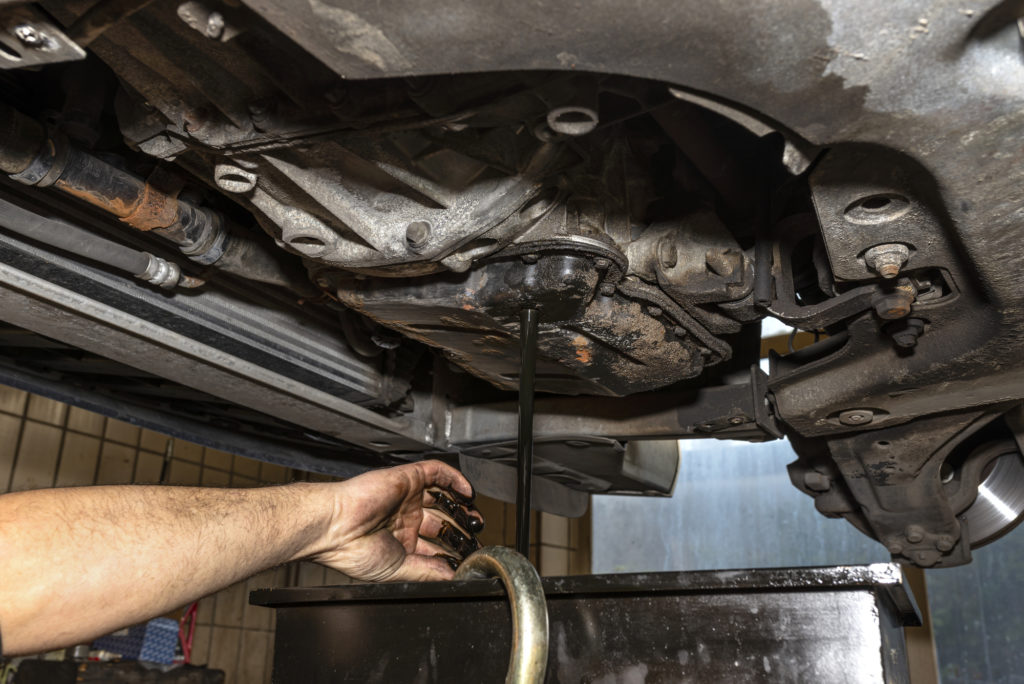
How Serious Is an Oil Pan Leak?
An oil pan leak is serious enough for you to want to address it sooner rather than later. If your car is leaking oil, that means it is losing oil that it needs to keep its engine cool, and a hot unlubricated engine will inevitably lead to significant damage to your vehicle.
What Does an Oil Pan Leak Look Like?
To detect an oil pan leak, go beneath your engine and look for any unusual brown or black fluids. You may need a flashlight for this even in the daytime, as it can sometimes prove challenging to make out wet surfaces beneath the vehicle. That said, if you see any brown or black fluids, that is a sign that your car is suffering from an oil leak.
Symptoms of Oil Pan Leaks
Here are some common symptoms of a leaking oil pan.
1) Oil Puddle Beneath Your Car
The most glaring symptom of an oil pan leak is if there is an oil puddle beneath your car.
You may see a puddle of liquid beneath your car and think nothing of it, but you should check to see what substance is leaking from your vehicle. If it is darker and looks like it’s staining the ground, you likely have an oil leak on your hands.
However, if you want to make sure that the puddle is oil and not something else, you can also smell the liquid to see if it smells like oil.
2) Oil on the Undercarriage
Your vehicle’s undercarriage should have a mostly clean look unless you do a lot of off-road driving on messy surfaces. Though even if you drive off road, you should never find oil on your car’s undercarriage.
If you find oil on the undercarriage, it is a sign that your car suffers from an oil pan leak. And note that it does not matter if you see a little or a lot of oil because any amount on the undercarriage is too much.
3) Low Oil Level
Having a low oil level is another symptom of an oil pan leak, especially if you find low oil levels after an oil refill.
You can quickly tell if your car’s oil level is low by looking on your dashboard to see if the low oil level warning light is on. The position of the low oil level warning light differs from car to car, but it is often at the bottom of the speedometer.
If the low oil level light is on, you should assume that your car is experiencing an oil leak or some other issue that is causing it to lose oil more quickly than usual.
4) Check Engine Light Comes on
Seeing the check engine light come on is one of the worst nightmares for any car owner, as it means at least one of many things is wrong with your car’s engine. There is a chance that a leaking oil pan is the cause of the light coming on, so when you see the warning, check the oil pan beneath your car as soon as possible.
5) Burning Oil Smell
When oil leaks out of the oil pan, there is a chance for it to have an extreme amount of heat which produces the smell of it burning, and it can worsen significantly if you keep driving.
If you’re ever driving and notice the smell of burning oil, you should stop your car immediately and try to locate the source. You can continue to drive afterward, though you should not drive for long as your car’s engine will start to suffer damage as more and more oil burns off and heat levels increase.
6) Smoking Engine
A smoking engine results from your car’s engine getting too hot, and this happens due to a lack of lubrication and cooling from proper amounts of oil.
The more oil that leaks from the oil pan, the more smoke you can expect to come from the engine. Because this symptom only happens when there is a severe lack of oil, you should try your best to detect an oil leak via one of the previous symptoms before reaching this point.
6 Reasons Why Oil Pans Leak
Now that you know some of the symptoms of a leaking oil pan let’s go over some common causes.
1) Damaged Oil Pan
If your oil pan suffers significant damage, it will more than likely start leaking oil immediately.
To avoid having this turn into an issue, ensure that the oil pan is one of the first things you check for damage if your car ever gets into an accident. You might find it difficult to determine the extent of the damage on your own, so strongly consider having a professional inspect the damages.
2) Driving Over Bad Terrain or Debris
While there are many ways for an oil pan to suffer damages, driving over terrain or debris is one of the most common.
Since the oil pan sits on the underside of your car, it is in the prime position to experience damage if you drive over something large enough to hit it. Even though this cause is common, it does not happen as often as you might think. However, it would be best to be cautious of driving over or on anything you feel might puncture or damage your oil pan.
3) Defective Oil Pan
In very rare cases, you might get a car with a defective oil pan right out of the box.
The oil pan may not appear to have any visible damage when you look at it, but if you immediately experience any of the symptoms from the section above, then the oil pan is likely defective in some way or another.
4) Old Oil Pan Gasket
If you have an older vehicle, the chances of its oil pan gasket going bad over time are not incredibly high, but it is a possibility that leads to an eventual oil leak.
Since this is the case, it is never bad to check your oil pan gasket for wear and tear if you think your car might have an oil leak issue. Ensure that you give the gasket a thorough inspection as well.
Because many things can cause an oil leak, this one alone is not necessarily a telltale sign of an oil leak, as an old oil pan gasket is not synonymous with a broken oil pan gasket.
5) Over-Torquing the Bolt of the Oil Pan
The bolts of an oil pan allow the pan to attach to the bottom of the engine and stay firmly in place.
Over time, these bolts can start to loosen and fall out entirely in rare cases, so it is essential to make sure they are always secure. However, torquing the bolts of an oil pan is a delicate process, as over-torquing them can cause damage.
Just like with any other part of the vehicle, it’s crucial to make sure everything is tight, but over-torquing is something you must also be cautious of.
6) Stripped Oil Pan Threads
Less common but still worth mentioning is oil leaking from the oil pan bolts due to stripped threads. This cause can occur due to over-tightening or cross-threading the oil drain bolt and is even more reason to use extra caution when doing any work with oil pan bolts.
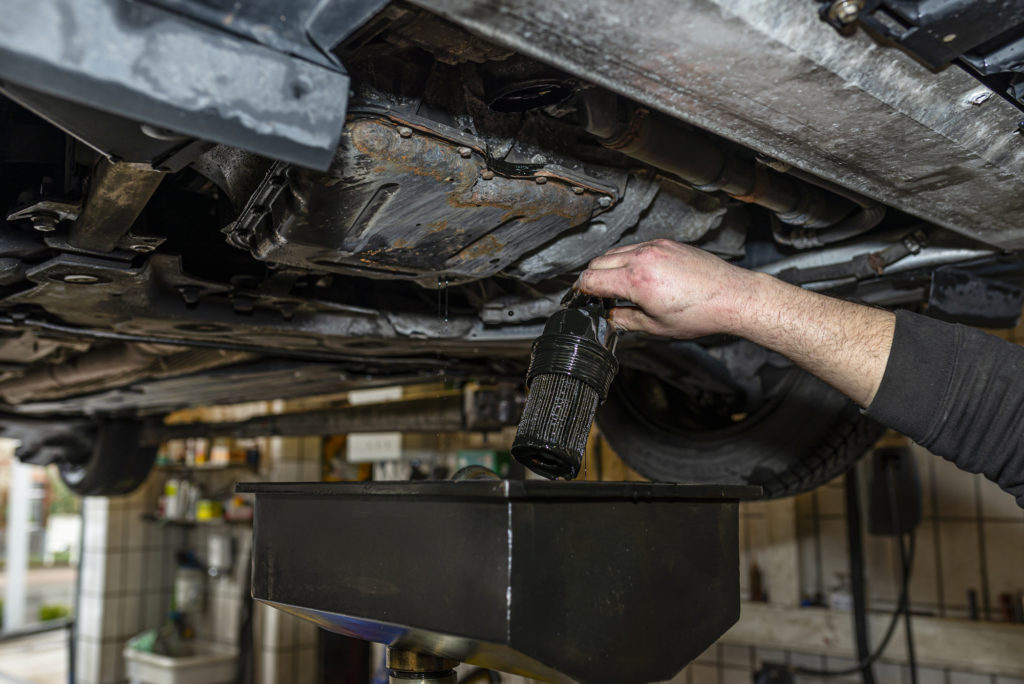
So, What Happens if You Notice an Oil Pan Leak?
If you notice an oil pan leak, the best thing that can happen is that you catch wind of it early on and can either fix it yourself or get it to an automobile repair shop as quickly as possible.
How to Fix Oil Leak From Oil Pan?
Suppose your oil pan is not leaking badly. In that case, you can try adding a product like BlueDevil Oil Stop Leak to your car’s engine to bring the oil pan gasket back to its original state, even if it has cracks or a hole.
However, if your oil pan is beyond repair and needs a complete replacement, then follow the steps below.
Tools and Equipment Needed
- Socket Ratchet
- Screwdriver
- Prybar
- Scraper
- Oil Pan Gasket
- Glue Or Sealer
Step 1: Unscrew the Plug for the Oil Pan
First, unscrew the central bolt for the oil pan, but be sure first to put a pan beneath the oil pan so that you have something to catch the oil with when it comes out. Once most of the oil is out, screw the plug back in.
Step 2: Unbolt the Bolts for the Oil Pan
Next, unbolt all the bolts for the pan using a socket ratchet and screwdriver. Once all the bolts are out, use a prybar to pull the pan off if your car’s oil pan stays on with glue.
Step 3: Remove and Clean the Oil Pan
After removing the oil, clean whatever residue is on the pan’s outer parts that connect to the vehicle. You can use a scraper for this part if there is dried glue or other tough substances on the pan.
Step 4: Use Glue or Sealant to Hold the Oil Pan Gasket in Place
To keep the oil pan gasket from coming off when you try to reattach it to your car, put some glue or sealant along the outer edges of the pan where it will connect. Then, attach the pan back to the bottom of the vehicle and use your socket ratchet to start putting the bolts back in place.
Step 5: Refill the Engine With Oil
Finally, refill the engine with oil after reattaching the oil pan gasket. That way, the engine does not blow due to having a lack of oil to properly cool and lubricate it.
How Much Will It Cost to Fix an Oil Pan Leak?
Depending on how badly your car’s oil pan leaks, getting a replacement could cost anywhere between $300 and $850. However, you should consult an automobile repair shop you trust to get a more accurate estimate.

